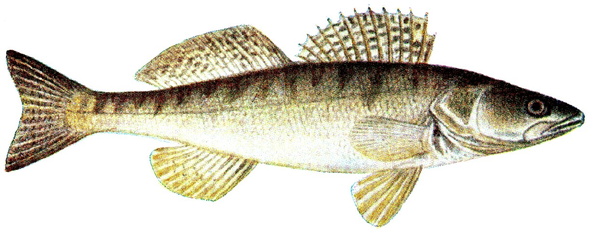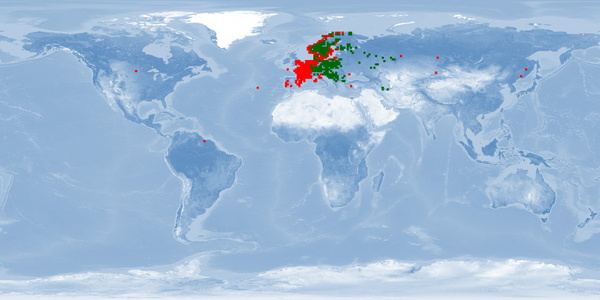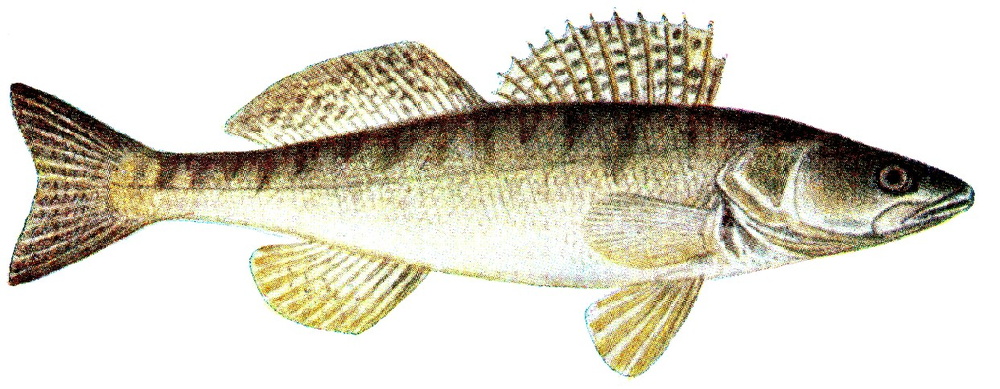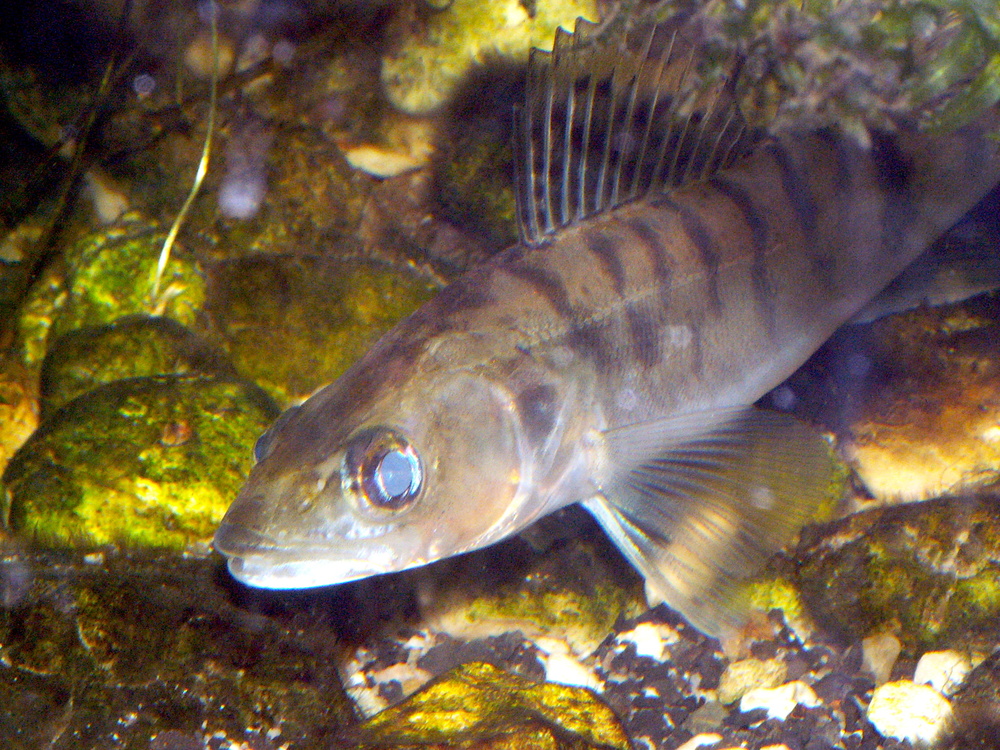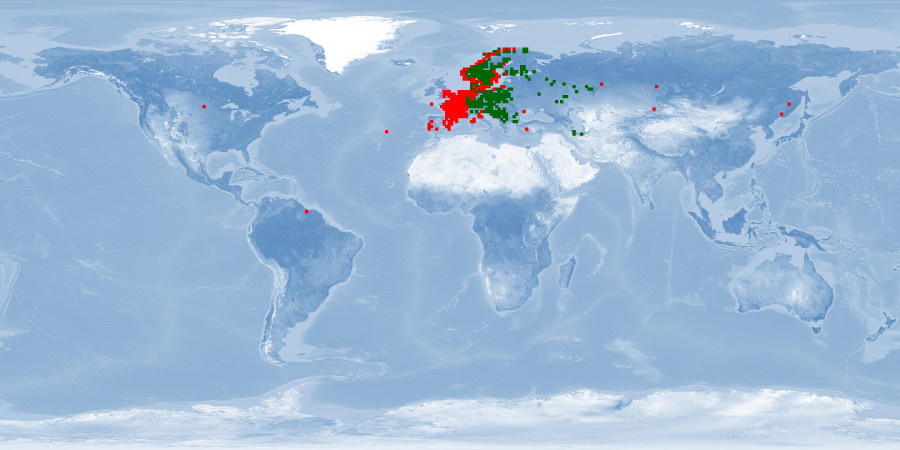Information
Version: B | 1.2 (2023-07-26)
B | 1.2 (2023-07-26)
link corrections
Changelog
1 Overview
2 General
- Escapes: rear only in environments where it naturally occurs D1 and prevent escapes. Else, escapees from fish farms have negative or at most unpredictable influences on the local ecosystem D2. Prepare for sexual maturity (and thus spawning) from 1-2 years or 26-37 cm or 424 g on for males and 1.5-3 years or 26-40 cm or 553 g on for females D3 and take measures against spawning into the wild.
3 Designing the (artificial) habitat
3.1 Substrate and/or shelter
- Substrate:
- Shelter or cover:
- Cover: avoid complete cover, as it increases stress A2 and decreases nest coverage A1.
- Vegetation: in the wild, move in open water without vegetation D4. Avoid natural or artificial vegetation (e.g., green buoyant polypropylene strings attached to PVC plate), as it decreases predation rate D5.
- Shelters: in the laboratory, juveniles hid in shelters before attacks D6. Provide natural or artificial shelters inside the system (e.g., parallel bricks D6) or outside.
3.2 Photoperiod
- Photoperiod: given the distribution D1 D7, natural photoperiod is 1-23 hours, depending on the season. Provide access to natural (or at least simulated) photoperiod and daylight. Keeping Pikeperch under 24 hours scotoperiod increases stress D8 and decreases nest coverage A1.
- Light intensity: to accommodate preference in juveniles (26 lux or even 1 lux) and for better growth (despite hardly any difference in food conversion ratio) D9, provide lower than higher intensity. Further research needed.
- Light colour: for better growth, provide red light but check for signs of distress D10. Further research needed.
- Resting period: allow Pikeperch a resting period at night or in the dark D11.
3.3 Water parameters
- Temperature: no clear temperature preference, probably best kept around 23 °C D12 D13. Further research needed. Below may mean lower growth D13. Adjust temperature when you notice avoidance behaviour D14 D15 D16. Implemented in aquaculture, temperatures >22 °C demand excellent oxygen levels D17 and a fine-tuned flow-through system to prevent bacterial load.
If temperatures <23 °C cannot be avoided, decrease water velocity D18.
For temperature and spawning ➝ A1. - Water velocity: no clear velocity preference D18. Provide variations in the direction and the velocity of the water inlet preferably between 0.01 and 0.9 cm/s depending on preference and temperature D18.
- Oxygen: in the wild, oxygen level is at 5.5-12.9 mg/L D17. Further research needed. Maintain oxygen level that ensures welfare depending on temperature (➝ Temperature) and stocking density (➝ A3).
- Salinity: given the semi-anadromous migration type, natural salinity is at freshwater level from egg to adult stage and brackish water level at adult stage D19 D20. The best salinity level for optimal growth depends on the acclimation salinity and water temperature D21. Further research needed.
- pH: in the wild, ph is at 6.5-6.9 D22. For the most natural solution, maintain this range. Further research needed.
- Turbidity: in the wild, water transparency is at 0.4-10.0 m Secchi depth D23. For the most natural solution, maintain turbidity at this range. Further research needed.
3.4 Swimming space (distance, depth)
- Distance: in the wild, travel up to 8 km, usually >1 km D24. Provide enough space, bearing in mind the planned stocking density A3.
- Depth:
- Depth range: in the wild, found at 0-31 m, usually 0-10 m D16. Provide at least 5-10 m, ideally up to 31 m, bearing in mind the planned stocking density A3.
- Flight: no ethology-based recommendation definable so far.
- Temperature layers: in habitats with water layers with different temperatures, prepare for individuals migrating to layers with preferred temperatures D12 D16, and avoid crowding in these layers by providing enough space.
4 Feeding
- Alternative species: carnivorous D25, trophic level 4.0 D26. If you have not yet established a Pikeperch farm, you might consider to opt for a species that can be fed without or with much less fish meal and fish oil in order not to contribute to overfishing by your business D27.
- Protein substitution: if you run a Pikeperch farm already, try to substitute protein feed components that have so far been derived from wild fish catch, while taking care to provide your fishes with a species-appropriate feed D25:
- Invite a feed mill and other fish farmers in your country to jointly establish a recycling syndicate that converts the remainders and the offcuts of fish processing into fish meal and fish oil, separating the production line corresponding to the species of origin in order to avoid cannibalism ➝ fair-fish farm directives (point 6).
- Inform yourself about commercially tested substitutes for fish meal and fish oil, like insect or worm meal or soy, with an appropriate amino and fatty acid spectrum.
- Feed delivery:
- Feeding frequency and time, feed delivery, self-feeders: in the wild, hunts D6, mostly crepuscular but also diurnal or nocturnal D11. Because of large inter-individual differences in activity rhythms, the most natural solution is to provide food at 1) varying intervals or 2) constant intervals but day as well as night, while making sure not to disturb the resting part of the population. If only diurnal feeding times are possible, make sure nocturnal individuals do not starve by closely monitoring individual weights. Alternatively, install a self-feeder and make sure all Pikeperch adapt to it. No ethology-based recommendation definable so far on feeding frequency as well as speed and pattern of feed delivery. Note decreased feeding at temperatures <18-20 °C D14 and reduce the food offered accordingly (if not using a self-feeder).
- Food competition: make sure to provide sufficient feed from ca 4 days after hatching on D28.
- Particle size: no ethology-based recommendation definable so far.
- Feed enrichment: no ethology-based recommendation definable so far.
5 Growth
- Maturity: in the wild, matures in the first or second year D3. Even if manipulating time of maturity were possible, refrain from it, as we have not found studies reporting possible long-term effects on welfare ➝ fair-fish database's understanding of fish welfare.
- Manipulating sex: even if manipulating sex were possible, refrain from it, as we have not found studies reporting possible long-term effects on welfare ➝ fair-fish database's understanding of fish welfare.
- Sex ratio: no ethology-based recommendation definable so far.
- Size-grading: no effect of size-grading on growth of fry and only temporal advantage in reducing cannibalism but higher manipulation losses especially in small-size groups D29. So, size-grading does not seem beneficial.
- Other effects on growth: no ethology-based recommendation definable so far.
- Deformities and malformations: larvae may suffer from non-inflated swim bladders with unknown cause D30. Further research needed.
- For growth and...
...light intensity ➝ A2,
...light colour ➝ A2,
...water temperature ➝ A4,
...salinity ➝ A4,
...stocking density ➝ A3.
6 Reproduction
- Nest building: male builds nest in sand D31. For the most natural solution, provide sand (without mud) of at least 50 cm diameter and 5-10 cm depth; alternatively, provide a synthetic material nest D31.
- Courtship, mating: respect courtship behaviour in which male and female encircle the nest D32. Allow for visual communication D33 as well as pair bond if individuals display monogamy.
- Spawning conditions: for spawning substrate ➝ Nest building (above). Respect natural spawning season in winter to spring and at temperatures of 10-15 °C D34 D35. Although lighting regime of "24 hours photoperiod" advances spawning by 14 days D35, refrain from it, as we have not found studies reporting possible long-term effects on welfare ➝ fair-fish database's understanding of fish welfare. Avoid full cover or 24 hours scotoperiod, as this decreases nest coverage D35. No ethology-based recommendation definable on salinity, water velocity, and depth. Respect the natural spawning sequence in which female spawns close to the nest, male average seven seconds later during up to three sessions, taking all in all average 30 seconds D36. Successful spawning has been achieved in male:female ratio of 1:1 D37. Further research needed for wild ratios.
For spawning and long-term handling ➝ A5. - Fecundity: in the wild, average 140,000-255,000 eggs per kg body weight D38. Males spawn up to three times per spawning D39. Even if manipulating fecundity were possible, refrain from it, as we have not found studies reporting possible long-term effects on welfare ➝ fair-fish database's understanding of fish welfare.
7 Stocking density
- Maximum: the businessplan should be calculated on the basis of a maximum stocking density that will never exceed the tolerable maximum with regard to fish welfare.
- Stocking:
- Stocking larvae: no ethology-based recommendation definable so far.
- Stocking juveniles and adults: in the wild, does not school D40. For better survival and growth, keep fry at <50 individuals/L, probably even <10 individuals/L D41 D42. Further research needed. For better welfare, keep juveniles at <350,000 individuals/ha in earthen ponds D43. Further research needed.
- Restriction:
- Habitat structuring: consider loss of space due to structures inside and outside the system A6 and calculate density accordingly.
- Environmental conditions: in the wild, displays a large variability in preferences for water temperature D12 and depth D16. Consider increased density at places with preferential conditions A4 A7 and calculate density accordingly.
- Aggregation: no ethology-based recommendation definable so far.
- Aggression: choose density given displayed aggression. Further research needed. Aggression may entail cannibalism D41.
- Territoriality: no ethology-based recommendation definable so far.
- Interaction: as show the above influence factors, stocking density is only one part of a complex interaction of factors to affect welfare. It should never be considered isolatedly.
8 Occupation
- Food search: adding substrate for food search does not apply, as Pikeperch is an active hunter ➝ A8.
- Challenges: if after decreasing stress A5 and providing everything welfare assuring, you still notice stereotypical behaviour, vacuum activities, sadness, then provide mental challenges, diversion, variety, and check reactions.
9 Handling, slaughter
9.1 Handling
- Stress coping styles: individuals differ in their ability to cope with stress D10, so assume the smallest common denominator during stressful situations and handle with care and high efficiency.
- Stress measurement:
- Stress reduction:
- Noise: no ethology-based recommendation definable so far.
- Directing individuals: no ethology-based recommendation definable so far.
- Cage submergence: no ethology-based recommendation definable so far.
- Pain treatment: no ethology-based recommendation definable so far.
- Handling: handle as carefully as possible, as it causes stress; avoid handling in fry before 18 days, as it increases mortality D47. Contradictory effects of long-term handling (no difference in cortisol levels but more non-spawners in stress than control group), so avoid long-term handling D48. Further research needed.
- Confinement: avoid confinement, as it causes stress D44. If unavoidable, after confinement for one hour, let recuperate for at least two days D44.
- Crowding: no ethology-based recommendation definable so far.
- Transport: after trawling and sorting, release undersized individuals as soon as possible, but not later than after 10 minutes, otherwise it increases mortality D43. Handle with great care, as handling is stressful D43; be especially careful with individuals <150 mm length, or avoid catching them altogether, as the mortality rate is 90% and higher D43. During sorting, chilling is not necessary and has no effect on mortality D43.
Avoid live transport, as it causes stress D43. If unavoidable, after transport for 1.5 hours, let recuperate for at least one day D43. - Disturbance: no ethology-based recommendation definable so far.
- For stress reduction and...
...cover ➝ A6,
...size-grading ➝ A9,
...stocking density ➝ A3.
9.2 Slaughter
- Stunning rules: render individuals unconscious as fast as possible and make sure stunning worked and they cannot recover D49.
- Stunning methods: prefer electrical stunning, because it renders individuals unconscious fast if administered correctly and with appropriate current D50. Further research needed for a specific protocol.
- Slaughter methods: bleed or gut individuals immediately after stunning, i.e. while unconscious.
10 Certification
- Certification: fair-fish international association warmly advises to follow one of the established certification schemes in aquaculture in order to improve the sustainability of aquafarming. Adhering to the principles of one of these schemes, however, does not result in animal welfare by itself, because all these schemes do not treat animal welfare as a core issue or as an issue at all. Therefore the FishEthoBase has been designed as a complement to any of the established certification schemes. May it help practitioners to improve the living of the animals they farm based on best scientific evidence at hand.
- To give you a short overview of the most established schemes, we present them below in descending order of their attention for animal welfare (which is not necessarily the order of their sustainability performance):
- The fair-fish farm directives are not present on the market, we cite them here as a benchmark.
 The directives address fish welfare directly by being committed to FishEthoBase: for each species, specific guidelines are to be developed mirroring the recommendations of FishEthoBase; species not yet described by FishEthoBase cannot be certified. In addition, the directives address a solution path for the problem of species-appropriate feeding without contributing to overfishing.
The directives address fish welfare directly by being committed to FishEthoBase: for each species, specific guidelines are to be developed mirroring the recommendations of FishEthoBase; species not yet described by FishEthoBase cannot be certified. In addition, the directives address a solution path for the problem of species-appropriate feeding without contributing to overfishing. - The Naturland Standards for Organic Aquaculture (Version 06/2018) generally address
 animal welfare with words similar to the fair-fish approach: "The husbandry conditions must take the specific needs of each species into account as far as possible (…) and enable the animal to behave in a way natural to the species; this refers, in particular, to behavioural needs regarding movement, resting and feeding as well as social and reproduction habits. The husbandry systems shall be designed in this respect, e.g. with regard to stocking density, soil, shelter, shade and flow conditions".
animal welfare with words similar to the fair-fish approach: "The husbandry conditions must take the specific needs of each species into account as far as possible (…) and enable the animal to behave in a way natural to the species; this refers, in particular, to behavioural needs regarding movement, resting and feeding as well as social and reproduction habits. The husbandry systems shall be designed in this respect, e.g. with regard to stocking density, soil, shelter, shade and flow conditions".
In the details, however, the standards scarcely indicate tangible directives for Pikeperch, except for percids in general when kept in sea cages: no grow-out in artificial tanks, stocking density limited to 10 kg fish/m3 max. Live transportation is limited to 10 hours max, to 1 kg/8 L max, and to adequate provision of oxygen, with water exchange after six hours. - The GAA-BAP Finfish and Crustacean Farms Standard (Issue 2.4, May 2017) directly
 addresses animal welfare: "Producers shall demonstrate that all operations on farms are designed and operated with animal welfare in mind." Farms shall "provide well-designed facilities", "minimize stressful situations" and train staff "to provide appropriate levels of husbandry". Yet the standard does not provide tangible and detailed instructions for the practitioner, let alone species-specific directives.
addresses animal welfare: "Producers shall demonstrate that all operations on farms are designed and operated with animal welfare in mind." Farms shall "provide well-designed facilities", "minimize stressful situations" and train staff "to provide appropriate levels of husbandry". Yet the standard does not provide tangible and detailed instructions for the practitioner, let alone species-specific directives.
In September 2017, GAA-BAP received a grant from the Open Philanthropy Project to develop best practices and proposed animal welfare standards for salmonids, tilapia, and channel catfish. Thus, fish welfare on GAA-BAP certified farms might become more tangible in the future, eventually also for Pikeperch at a later date. - The GlobalG.A.P. Aquaculture Standard (Version 4.0, March 2013) "sets criteria for legal
 compliance, for food safety, worker occupational health and safety, animal welfare, and environmental and ecological care". The inspection form includes criteria like "Is the farm management able to explain how they fulfil their legal obligations with respect to animal welfare?", "If brood fish are stripped, this should be done with the consideration of the animal's welfare." or "Is a risk assessment for animal welfare undertaken?". The scheme claims that 45 out of a total of 249 control points cover animal protection, yet it does not provide any tangible directives, let alone species-specific directives.
compliance, for food safety, worker occupational health and safety, animal welfare, and environmental and ecological care". The inspection form includes criteria like "Is the farm management able to explain how they fulfil their legal obligations with respect to animal welfare?", "If brood fish are stripped, this should be done with the consideration of the animal's welfare." or "Is a risk assessment for animal welfare undertaken?". The scheme claims that 45 out of a total of 249 control points cover animal protection, yet it does not provide any tangible directives, let alone species-specific directives. - The ASC Aquaculture Stewardship Council.
 The ASC standards address fish welfare only indirectly, as a function of a “minimum average growth rate" per day, a "maximum fish density at any time", and a "maximum average real percentage mortality". fair-fish sees animal welfare as an intrinsic value, not just as a result of optimising neighbouring values like health care and management procedures.
The ASC standards address fish welfare only indirectly, as a function of a “minimum average growth rate" per day, a "maximum fish density at any time", and a "maximum average real percentage mortality". fair-fish sees animal welfare as an intrinsic value, not just as a result of optimising neighbouring values like health care and management procedures.
There is no ASC standard for Pikeperch so far.
In November 2017, ASC received a grant from the Open Philanthropy Project to develop an evidence-based fish welfare standard that is applicable to all ASC-certified species. ASC intends to share its approach to fish welfare with all farms engaged with the ASC program and encourage adoption of it, which means that the fish welfare standard will function as a non-mandatory add-on to the ASC certification. - The Friend of the Sea (FOS) Standards for freshwater aquaculture of fish (revised October 2016)
 do not even address animal health or animal welfare issues.
do not even address animal health or animal welfare issues.
In May 2017 however, FOS signed a Memory of Understanding with fair-fish international on developing fish welfare criteria for the FOS standard. In November 2017 fair-fish international association received a grant from the Open Philanthropy Project to assess the welfare of fish on FOS certified farms, develop farm-specific recommendations, and to develop animal welfare criteria for the FOS standard. Thus, fish welfare on FOS certified farms might become tangible in the future.
- The fair-fish farm directives are not present on the market, we cite them here as a benchmark.
❮
❯



«

